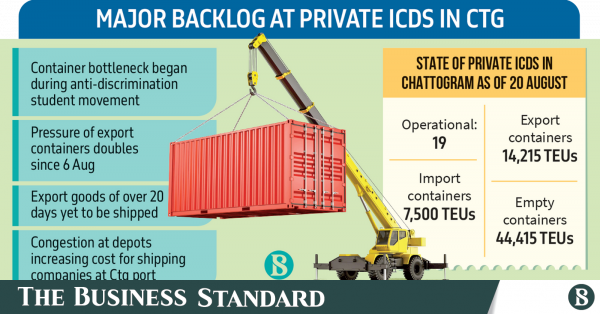Ctg ICDs unable to shake off backlog, exporters fear order cancellation


Though more than two weeks have gone by, the pressure on private inland container depots (ICDs) in Chattogram has not decreased yet as the number of export containers at the depots are still nearly double the usual amount.
The depots are now experiencing a major backlog, causing delays in meeting shipment schedules. Export goods that arrived over 20 days ago are yet to be shipped, according to depot owners.
They said the bottleneck at the depots and the port was mainly due to the recent anti-discrimination student movement during which port activities were disrupted in two phases.
According to the Bangladesh Inland Container Depots Association (BICDA), the number of export containers at private depots typically ranges from 7,000 to 8,000 TEUs (twenty-foot equivalent units). However, since 6 August, this figure has remained at an elevated 14,000 to 15,000 TEUs.
As of yesterday, the figure stands at 14,215 TEUs, nearly double the normal capacity.
Rakibul Alam Chowdhury, vice president of the BGMEA, said the congestion has led to a shortage of empty containers, preventing the loading of export products at depots.
“Exporters are concerned that if goods are not shipped on time, they may face cancelled orders or be forced to offer discounts,” he added.
However, according to exporters and depot owners, the backlog cannot be cleared without the deployment of additional ships from Chattogram port.
Maersk Line introduced a new shipping service called SH3 in July, adding one vessel per week to Chattogram port via several Asian ports. Additionally, the mainline operator Pacific International Lines (PIL) is set to launch a new service from Ningbo, China, on 31 August, which will also add a weekly vessel to Chattogram.
Traders hope that these new services from PIL and Maersk Line will help alleviate the congestion at the port, but they believe that adding more ships to the transshipment routes connecting Chattogram port with transshipment ports like Singapore and Colombo will further ease the congestion.
Shamsuddin Ahmad Chowdhury, secretary of the Bangladesh Container Shipping Association, told TBS that the congestion has extended ship turnaround times at the port. “Previously, ships could enter the jetty within a day after arriving at the port’s outer anchorage, but now it takes five to six days, reducing the number of voyages per ship from 2.2 to 1.6 per month. This has increased costs and time for shipping companies,” he added.
Despite the new shipping services, Shamsuddin warned that the situation is unlikely to return to normal before mid-September due to the current berthing arrangements at the port.
Currently, around 90 container ships operate from Chattogram port to transshipment hubs, each capable of carrying between 1,600 and 2,400 export containers. After being offloaded at these hubs, the containers are transferred to larger vessels for transport to Europe and the United States.
On the import side, conditions are improving. The number of containers stored at Chattogram port’s yard has decreased from over 44,000 TEUs last week to 39,100 TEUs as of yesterday.
The Chittagong Port Authority (CPA) considers 30,000 to 35,000 TEUs a normal level. Over the past week, about 6,000 import containers have been cleared, and officials expect the number to decrease further within the next week.
Talking to TBS, Md Omar Faruk, secretary of the CPA, said the situation with cargo loading and container congestion is gradually returning to normal and is expected to normalise within a few days.




